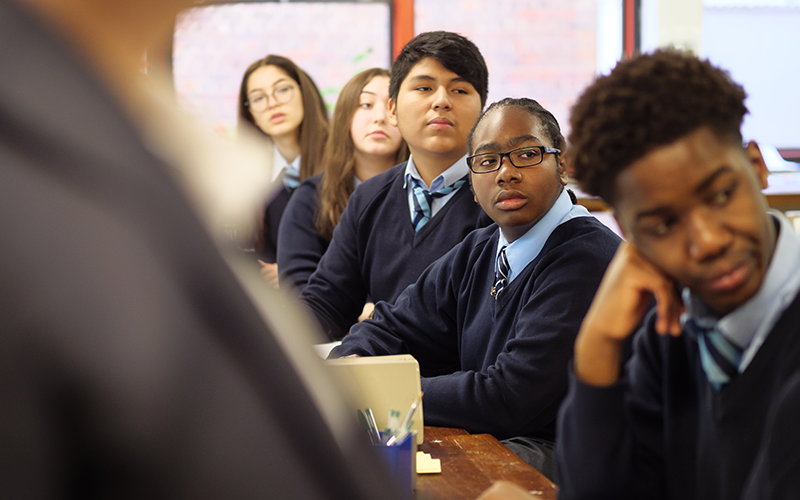Setting pupils by attainment unlikely to boost attainment, but specific activity grouping might
7 September 2018
Grouping pupils by attainment for specific activities in their usual classes is more likely to boost attainment than setting, results from a UCL Institute of Education (IOE) trial programme show.

This work has informed an update to the Teaching and Learning Toolkit published by the Education Endowment Foundation (EEF) today (Friday 7 September).
The EEF Toolkit is used by up to two-thirds of all schools in England and summarises international evidence to inform teachers and school leaders which strategies are likely to boost attainment for their pupils. Today’s update includes a new strand on “within-class attainment grouping” and revises the existing “setting and streaming” strand.
It finds that, on average, “setting or streaming” – where pupils with similar levels of current attainment are grouped together for lessons – is unlikely to boost learning for all pupils. However, “within-class attainment grouping” – where pupils with similar current attainment are grouped together for specific activities within their usual class and with their usual teacher – can lead to average gains of around three additional months’ progress per year. However, lower attaining pupils appear to benefit less from this approach than their classmates.
The practice of grouping varies across English schools, with some schools grouping pupils by current attainment for all lessons, or for maths and English; others grouping pupils by attainment within mixed classes; and some not grouping according to attainment at all.
To find out how schools can group pupils in ways that benefit all pupils, IOE academics developed an EEF-funded programme.
The main trial tested an intervention that aimed to get schools to improve their setting practice, which research suggests can harm progress for pupils in the lower sets. The programme was designed to help schools address poor practices, including misallocating pupils to the ‘wrong’ groups and low expectations of those in lower sets.
127 schools took part in the trial, which ran over the course of two academic years. The intervention involved randomly allocating teachers to sets to prevent ‘lower’ sets from being disproportionately assigned less experienced teachers, while Years 7 and 8 students were assigned to sets based on independent measures of attainment, rather than more subjective judgements such as behaviour and peer interactions. There were opportunities throughout the year to re-assign students to different sets based on their current level of attainment.

A smaller pilot study in the same programme explored ways to introduce mixed attainment teaching to secondary schools and to overcome the common barriers to this approach. Schools were expected to create classes of Year 7 and Year 8 pupils with a wide range of attainment at Key Stage 2. Teachers were trained to communicate high expectations to all their pupils and use flexible grouping techniques with their classes.
However, it was difficult to persuade schools to adopt mixed attainment teaching so recruiting schools to take part was hard. Independent evaluators from NFER found that staff in schools that did take part had mixed views on the intervention, with some enjoying it, and others struggling to tailor their teaching to pupils with different levels of attainment in mixed attainment sets.
Despite these mixed views, and the low take-up, most interviewees felt that the intervention had a positive effect on student outcomes; with most believing that the least able students had particularly benefitted.
Professor Becky Francis, Director of UCL Institute of Education, said:
“Given what we know about the risks, minimising setting and certainly streaming, is something for teachers to think about.
"Our [Best practice in grouping students] project has been providing further evidence of how setting practices exacerbate social segregation within schools, the scale of misallocation, and how set placements can be biased by ethnicity and gender. This is important given the impact of set level on the nature and quality of teaching and curriculum that pupils receive.
“Any setting practice should ensure set placements are strictly on the basis of prior attainment in that specific subject area and not letting other factors play into that. And this is something that is quite difficult to ensure in practice."
Sir Kevan Collins, Chief Executive of the Education Endowment Foundation, said:
“How to group pupils for lessons – whether in sets, or in classes with mixed attainment – is something that’s of huge interest for parents and schools alike. Traditionally, setting has tended to benefit those pupils in the top sets, with little known about out how to group pupils in ways that aren’t detrimental to those in the lower sets.
“What these new publications tell us is that grouping pupils by attainment for specific activities in their usual classes is more likely to boost attainment than setting or streaming. The findings from the two trials also tell us how hard it is to get schools to adopt new approaches to grouping by attainment, when many don’t have the capacity to adopt new ways of working.”
Professor Steve Higgins, author of the Teaching and Learning Toolkit, said:
“The updated Toolkit analysis shows us that the impact of attainment grouping is dependent on the type of grouping used. Based on the evidence we have, setting or streaming pupils in different classes by prior attainment appears, on average, to have had a small negative effect. In contrast, grouping pupils by attainment within classes had a positive overall impact in the studies we reviewed.
“However, both types of grouping appear to be more beneficial for higher attaining pupils than for lower attaining pupils, and lower attaining pupils tend to be disproportionately from disadvantaged backgrounds. The effects are small and we do not yet fully understand the reasons for these effects. Overall the quality of teaching is going to be more important than the type of grouping.”
Professor Becky Francis and Professor Jeremy Hodgen will outline the findings of the best practice in grouping students project at the ResearchED conference in London tomorrow (Saturday 8 September).
Media contact
Henry Killworth, UCL Media Relations
Tel: +44 (0) 20 7679 5296
Email: h.killworth@ucl.ac.uk
Links
- Best practice in grouping students
- View Professor Becky Francis’ research profile
- Q&A with Professor Becky Francis
- Education Endowment Foundation
- Teaching and Learning Toolkit
 Close
Close

